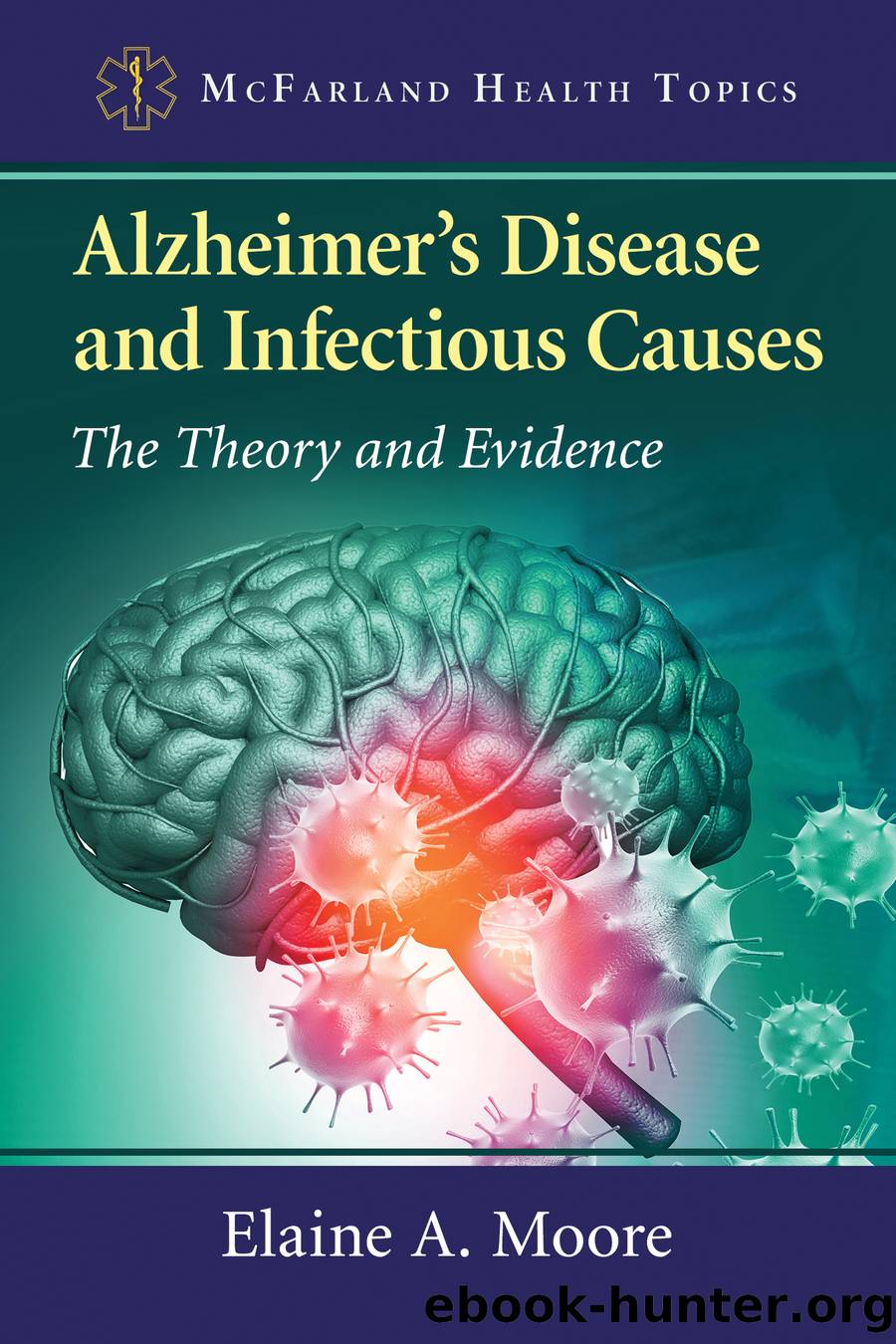Alzheimer's Disease and Infectious Causes by Elaine A. Moore

Author:Elaine A. Moore
Language: eng
Format: epub
Publisher: McFarland & Company, Inc., Publishers
Published: 2020-03-28T00:00:00+00:00
Herpes Zoster Ophthalmicus (HZO)
Varicella zoster virus (VZV) is the only human virus that can replicate in cerebral arteries and produce vascular disease. This result primarily occurs in elderly and immunocompromised patients. VZV spreads transaxonally to cerebral arteries that feed the trigeminal nerve, particularly from the ophthalmic branch of the trigeminal nerve’s afferent fibers. The trigeminal nerve is the fifth cranial nerve and is responsible for sensation and motor functions in the face.
The presence of VZV, which when activated becomes the Herpes zoster virus, results in even greater vascular inflammation and thrombosis, which have the ability to injure brain cells. VZV-related vascular disease has been previously found to potentially cause transient ischemic attacks, stroke, aneurysms, venous sinus thrombosis and arterial dissection. Compared to patients with Herpes zoster without eye involvement (HZV), patients diagnosed with HZO had a greater risk for stroke, a known risk factor for dementia (Tsai et al. 2017).
Researchers in Taiwan studied the records of 846 patients with Herpes zoster opthalmicus (HZO) using the Taiwan Longitudinal Health Insurance Database. These subjects were matched with 2,538 patients without HZO. Each patient was individually followed for a 5-year period to assess whether they received a diagnosis of dementia during this period. From this information, and using a using a Cox proportional hazards regression, hazard ratios (HRs) were calculated. The crude HR of dementia during the follow-up period was 2.83 for patients with HZO compared to patients without HZO. After the results were adjusted for patient characteristics and comorbid disorders, they indicated a 2.97-fold greater risk for dementia in all patients with HZO when compared to the control subjects. For males, the crude HR for dementia was higher, at 3.35.
At the end of the follow-up period, 4.61 percent of patients with HZO received a diagnosis of dementia compared to 1.65 percent of patients in the larger control group without HZO. The study’s authors noted that psychological stress, aging, a poor social support environment, and adverse life events may contribute to both VZV reactivation and dementia. The study did not indicate whether patients used antiviral drugs (Tsai et al. 2017).
A number of studies show significantly higher amounts of various herpes viruses—particularly HSV-1, HSV-2, CMV, and human herpes viruses 6 and 7—in the brains of patients with Alzheimer’s disease when compared to control subjects with no signs of dementia. Because these viruses are present in the majority of people, finding low concentrations of herpes viruses in the brains of individuals free of dementia is not uncommon.
Download
This site does not store any files on its server. We only index and link to content provided by other sites. Please contact the content providers to delete copyright contents if any and email us, we'll remove relevant links or contents immediately.
When Breath Becomes Air by Paul Kalanithi(7263)
Why We Sleep: Unlocking the Power of Sleep and Dreams by Matthew Walker(5641)
Paper Towns by Green John(4169)
The Immortal Life of Henrietta Lacks by Rebecca Skloot(3826)
The Sports Rules Book by Human Kinetics(3588)
Dynamic Alignment Through Imagery by Eric Franklin(3488)
ACSM's Complete Guide to Fitness & Health by ACSM(3468)
Kaplan MCAT Organic Chemistry Review: Created for MCAT 2015 (Kaplan Test Prep) by Kaplan(3423)
Introduction to Kinesiology by Shirl J. Hoffman(3299)
Livewired by David Eagleman(3121)
The River of Consciousness by Oliver Sacks(2992)
Alchemy and Alchemists by C. J. S. Thompson(2911)
The Death of the Heart by Elizabeth Bowen(2901)
Descartes' Error by Antonio Damasio(2731)
Bad Pharma by Ben Goldacre(2729)
Kaplan MCAT Behavioral Sciences Review: Created for MCAT 2015 (Kaplan Test Prep) by Kaplan(2491)
The Gene: An Intimate History by Siddhartha Mukherjee(2491)
The Fate of Rome: Climate, Disease, and the End of an Empire (The Princeton History of the Ancient World) by Kyle Harper(2436)
The Emperor of All Maladies: A Biography of Cancer by Siddhartha Mukherjee(2431)
